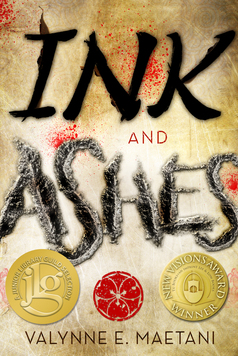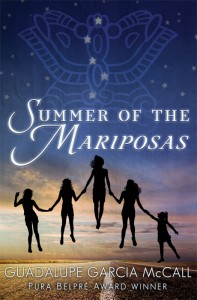The more I dig into this particular generation of my family–the immigrants I’d been chasing for decades to figure out where they’d come from in East Prussia–the more I’m confused. This has been a nearly 30-year research journey, so join me on a story.
Here’s what I know:
Henry and Bertha Whitman are the immigrant generation. All we know is that Henry changed his name and that they’re from East Prussia. He came after her and stayed with her people in Chicago, so the family story goes.
Bertha and Fern were sister and brother. (We know she had other siblings, but don’t know who they were.) The story of Henry’s name change we’ll get to in a sec.
My grandpa, with his parents, visited Fern on his farm during the drought of the Great Depression at around age 10 in Red Hook, NY, where he also met Fern’s wife, Ella. Fern and Ella never had kids.
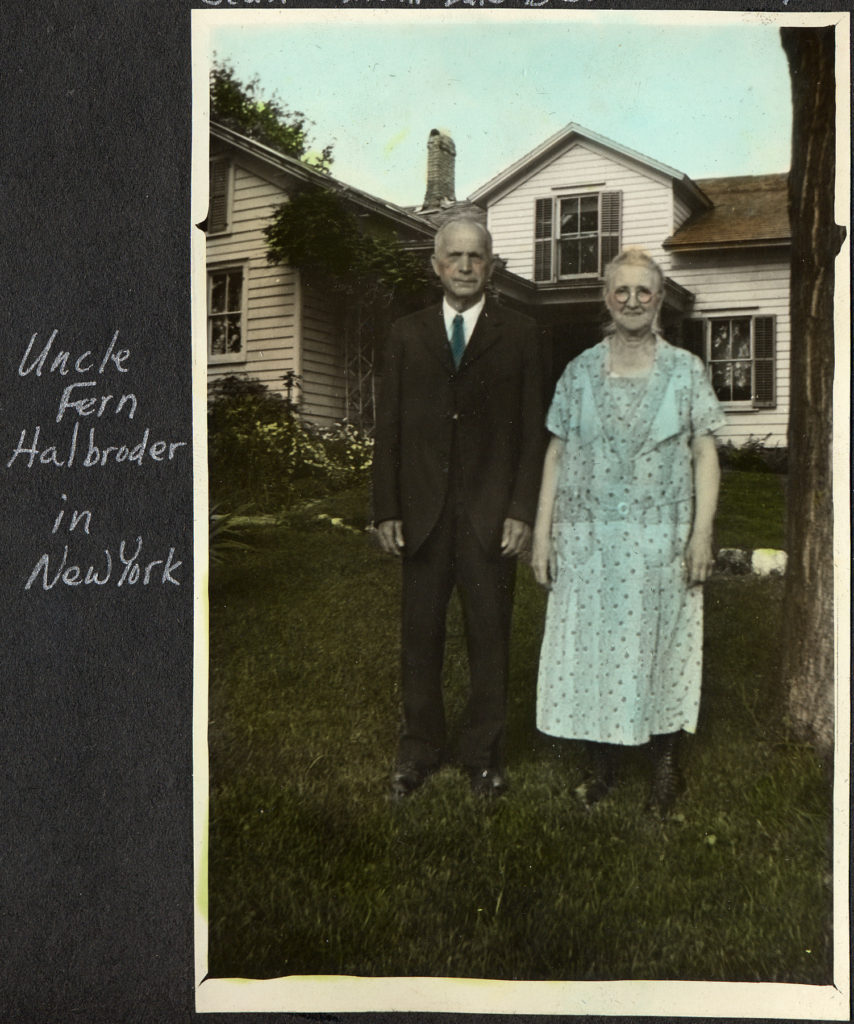
That’s all I’ve known since around 2000, when I interviewed my Grandpa Dale before he died. I’ve been researching this branch of the family since about 1993, though, and other family members before me have tried and failed to figure out Henry and Bertha’s origins.
But finding out about the brother from Grandpa was the start of a breakthrough. I was able to trace Fern’s life backward from NY throughout the US. He homesteaded for a few years in Colorado and Nebraska, which is where he met Ella.
On his marriage certificate to Ella, their parents were listed! A miracle!
Parents of Fern: August Halbroeder and Caroline Koenitzer, from East Prussia.
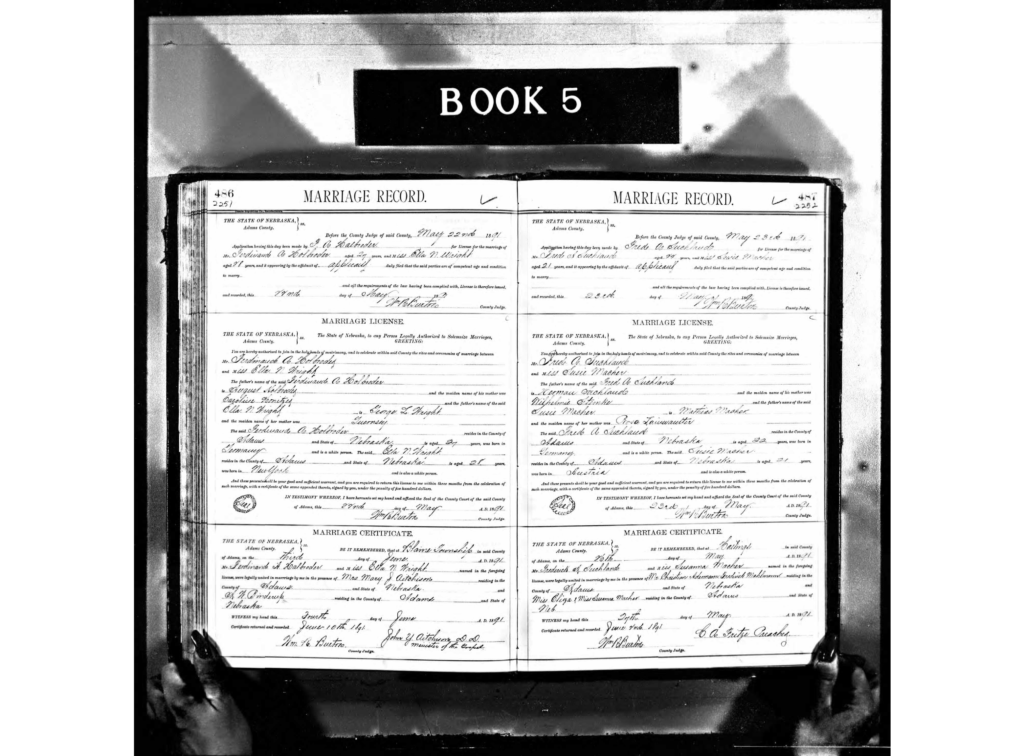
These are, we presume, ALSO the parents of Bertha. Because siblings, right?
So I start probing for Halbroeder/Halbröders in the Chicago area/northern IL anytime in the neighborhood of the early 1870s, as the family story goes that Henry was avoiding the draft of Bismarck/William the 1st to get here before the unification wars. (No idea how accurate that story is, but it’s a starting point.)
Could I find them on the census in 1870? It’s a stretch, because they may have come after the census was taken. Nope, no dice.
We know Bertha and Henry’s marriage date, by the way, thanks to the Whitman Family Bible, in my uncle’s possession (5 Mar 1876).
While there’s no census, I do find them! And I find an August! Two, actually, who appear to be father and son, maybe? In various city directories, which don’t give much information, but how many Halbröders who aren’t related can there BE?
I don’t remember if this breakthrough came before or after I found Bertha’s marriage license in Cook County–which I paid $15 or so for a copy of rather than rely on records because IT GAVE ME HENRY’S ORIGINAL NAME. Henry Whitman was … well, I’m not sure if he was born Gottlieb Wittmann, because that might have been an alias to get him on the boat, but he was using the name Gottlieb Wittmann at least until the moment he married Bertha, and not much longer, because every record after this I can find is definitely Henry Whitman. And it’s definitely them—the ages are spot on and the marriage date, 5 March 1876, is correct.
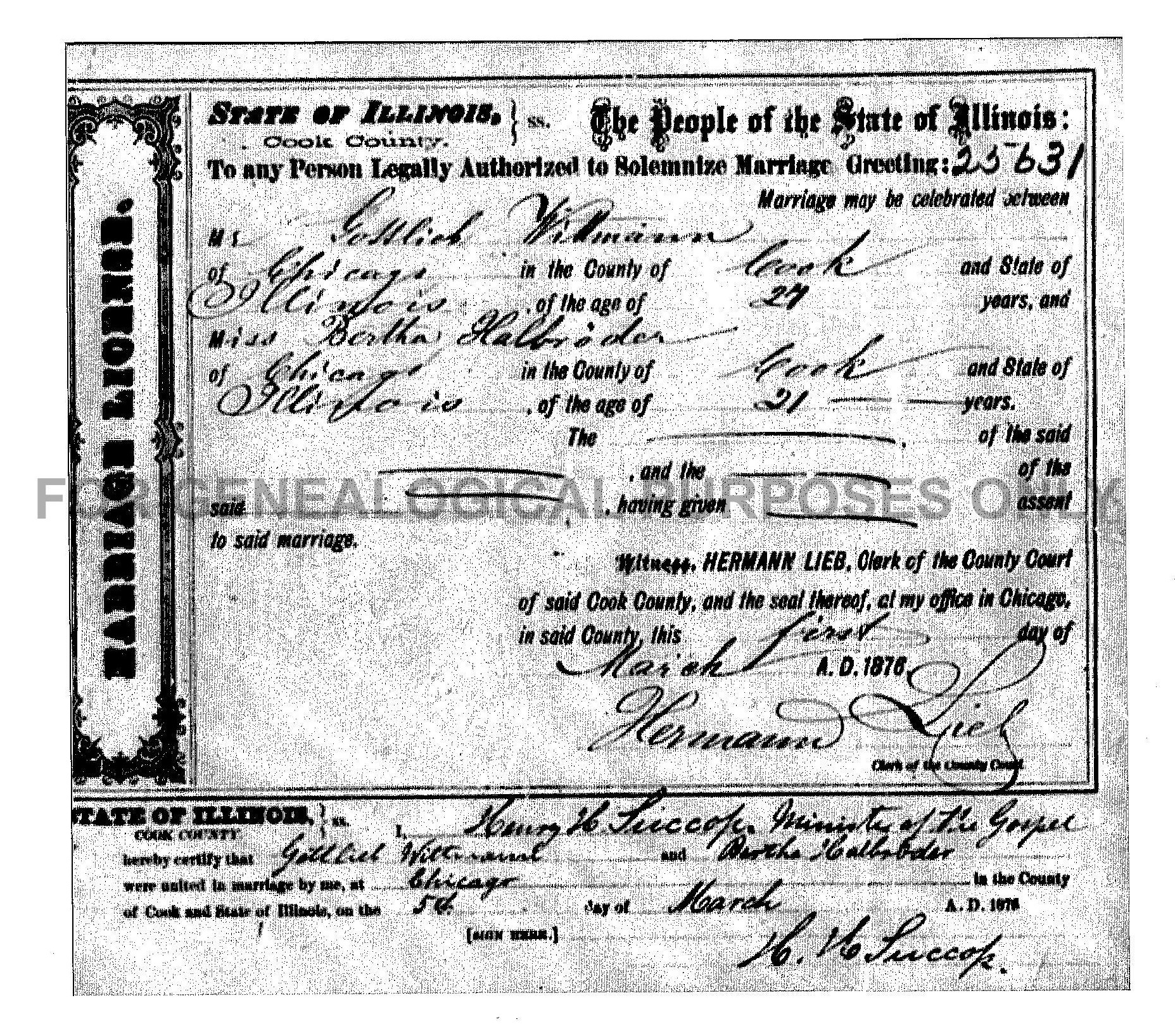
And at that point, Ancestry has coughed up some IMMIGRATION RECORDS, the holy grail for tracing to source country, yay!
HERE’S WHERE IT GETS WEIRD.
I find Bertha Halbröder entering the country at age 14 in 1869 alone? with a brother? maybe with an uncle? But she’s clearly with a woman sharing the same name as the name of Fern’s mother, with a different man who is not named Halbröder, but who rather shares the last name of the presumed mother’s maiden name. Maybe Fern didn’t know what a maiden name was and his parents were divorced and his mother married a guy named Konitzer?
And then Fern (full name: Ferdinand) is NOT on the boat with her. No, she’s traveling with a guy named Wilhelm Halbröder, from the same area of Prussia:


on the Steamer Harmonia on 19 May 1869
I have no idea who Emilie Bischof is–she doesn’t appear in any Whitman/Halbröder records past this point, so they might have just been village friends who escorted her to her new life. But Carl and Caroline Konitzer are a MYSTERY. We’ll get to more on that in a minute.
Fern doesn’t arrive for TWO MORE YEARS, and he arrives with a guy whose name we know from Fern’s marriage certificate: August Halbröder, who has a whole family that we’ve never known the names of before.

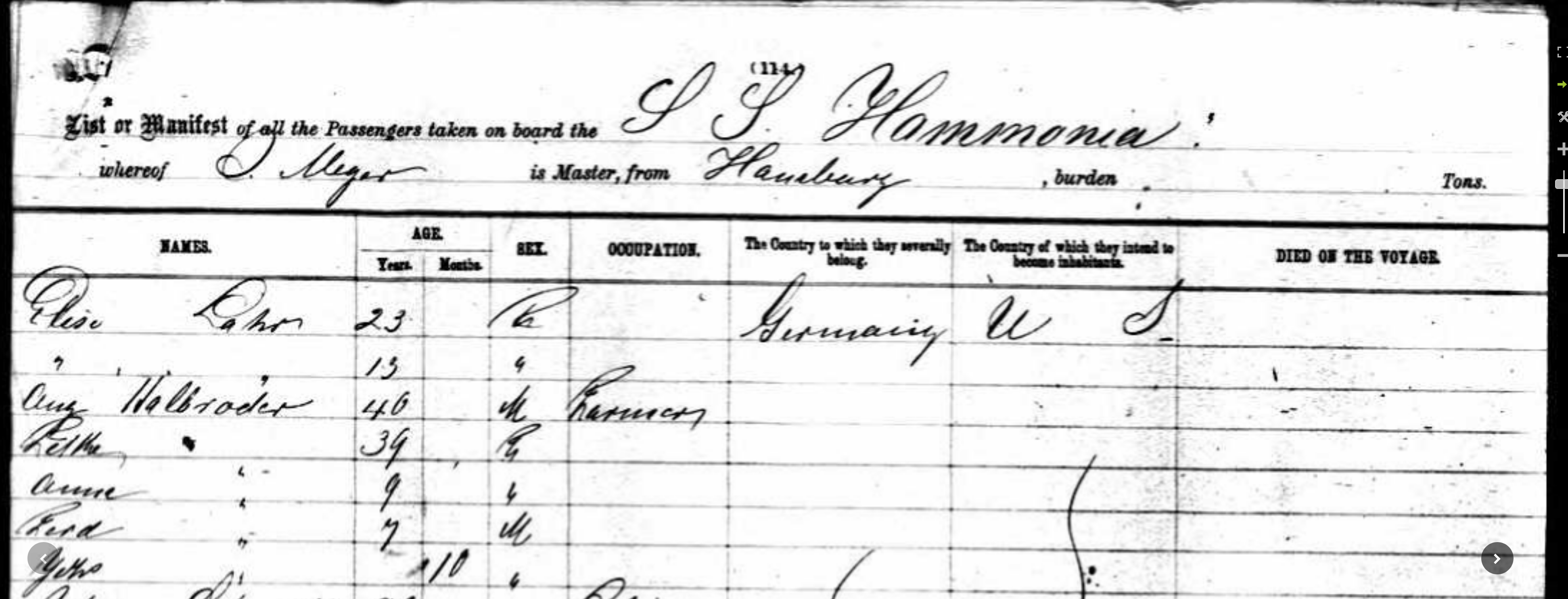
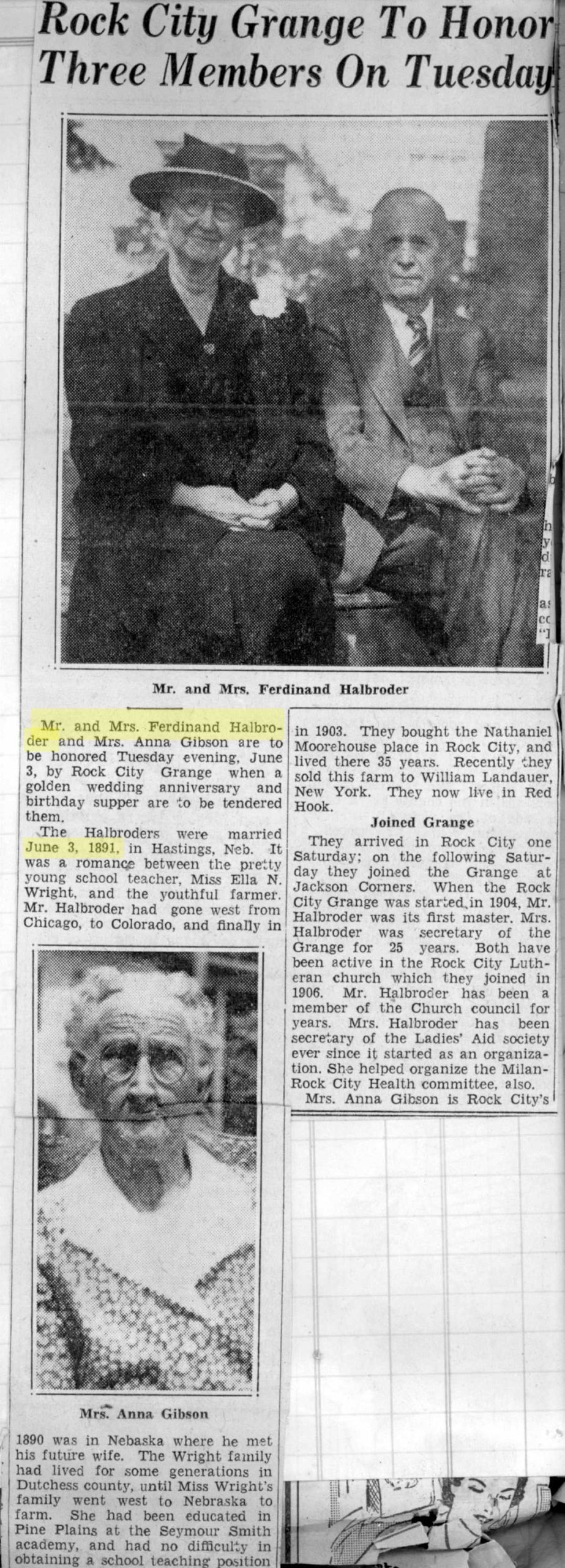
Note that the Hamburg departure manifest gives us a BIG clue on the German/Prussian side: previous residence! Stettin, now known as a Polish city Szczecin. It’s likely just the region they were from—August is listed as a farmer, so it’s likely they’re from a hamlet or village near Stettin—but it gives us a place to START in German research (once I learn enough German to parse out the handwriting—I can read English journals from the 1800s like it’s nothing nowadays, but German is THE WORST for parsing once you go back in time past a certain point).
Okay, so we’ve got a point of origin, but are the Bertha and Fern in these manifests the same Bertha and Fern who we know for certain were brother and sister? I’m pretty sure–the dates match up, as do the circumstances based on what we know from later census records like the 1900 census, which lists arrival years for immigrants, and an article about Fern and Ella on their golden wedding anniversary. Not to mention that the names Bertha Halbröder and Ferdinand A. Halbröder are SUPER UNIQUE. Maybe not 100% unique, but pretty unique!
While the years aren’t exact, I expect census records to be a bit off—ages get fudged, spelling is atrocious because it’s an enumerator doing the writing, and you expect people’s math to be a little off sometimes. (Bertha cannot have been in the US for 38 years in 1900 and also have arrived in 1868. She would have been there for 32 years.)
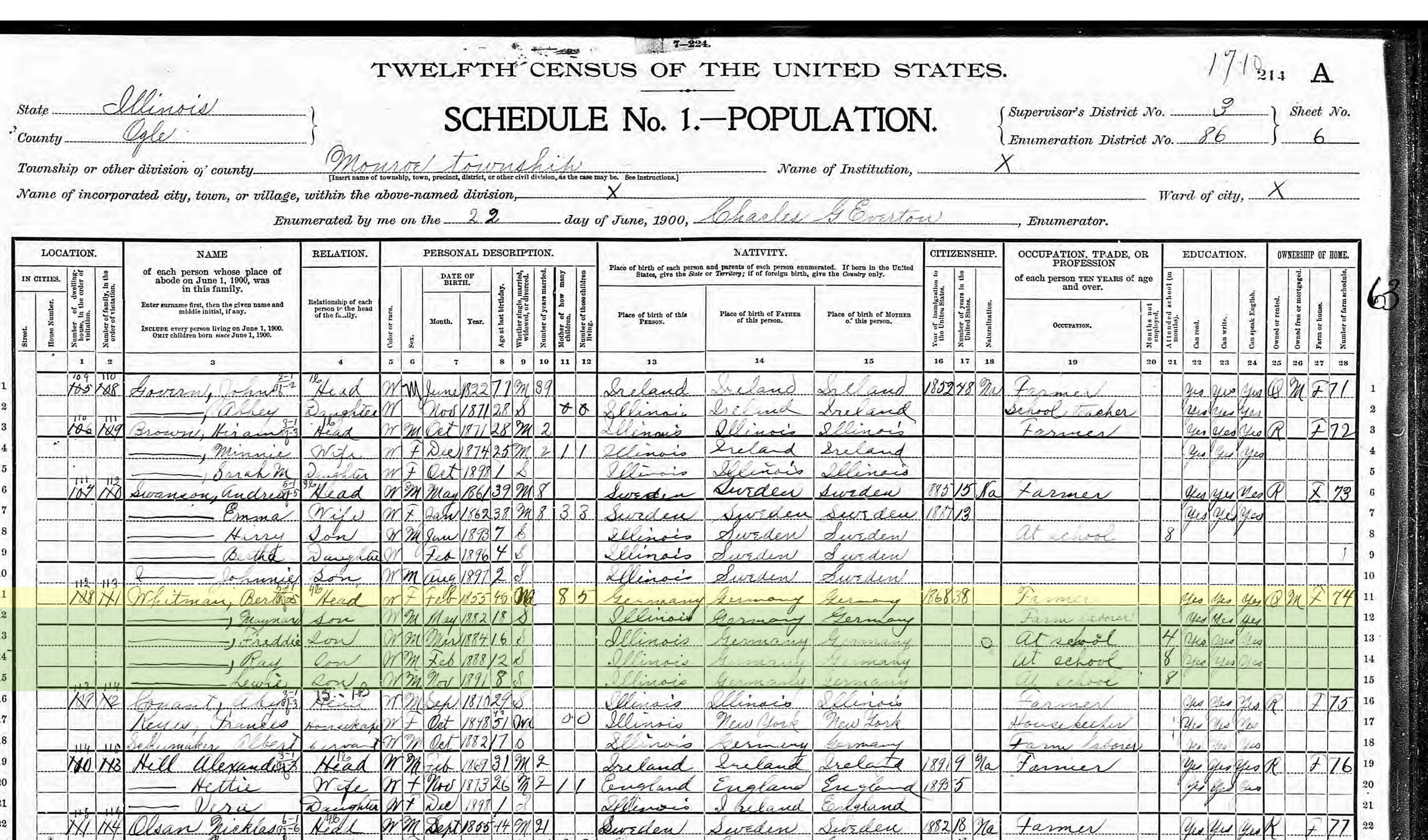
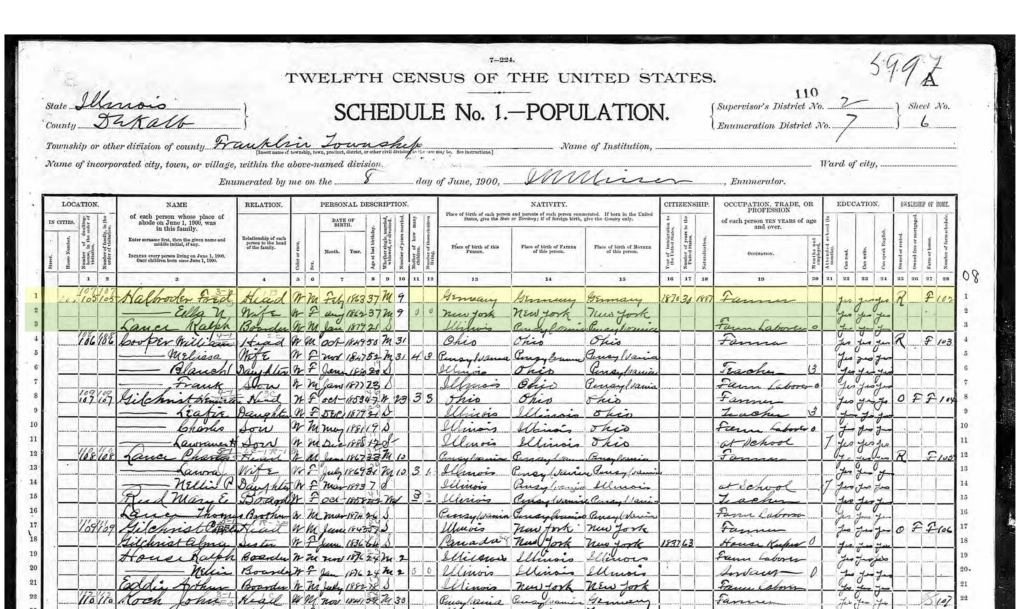
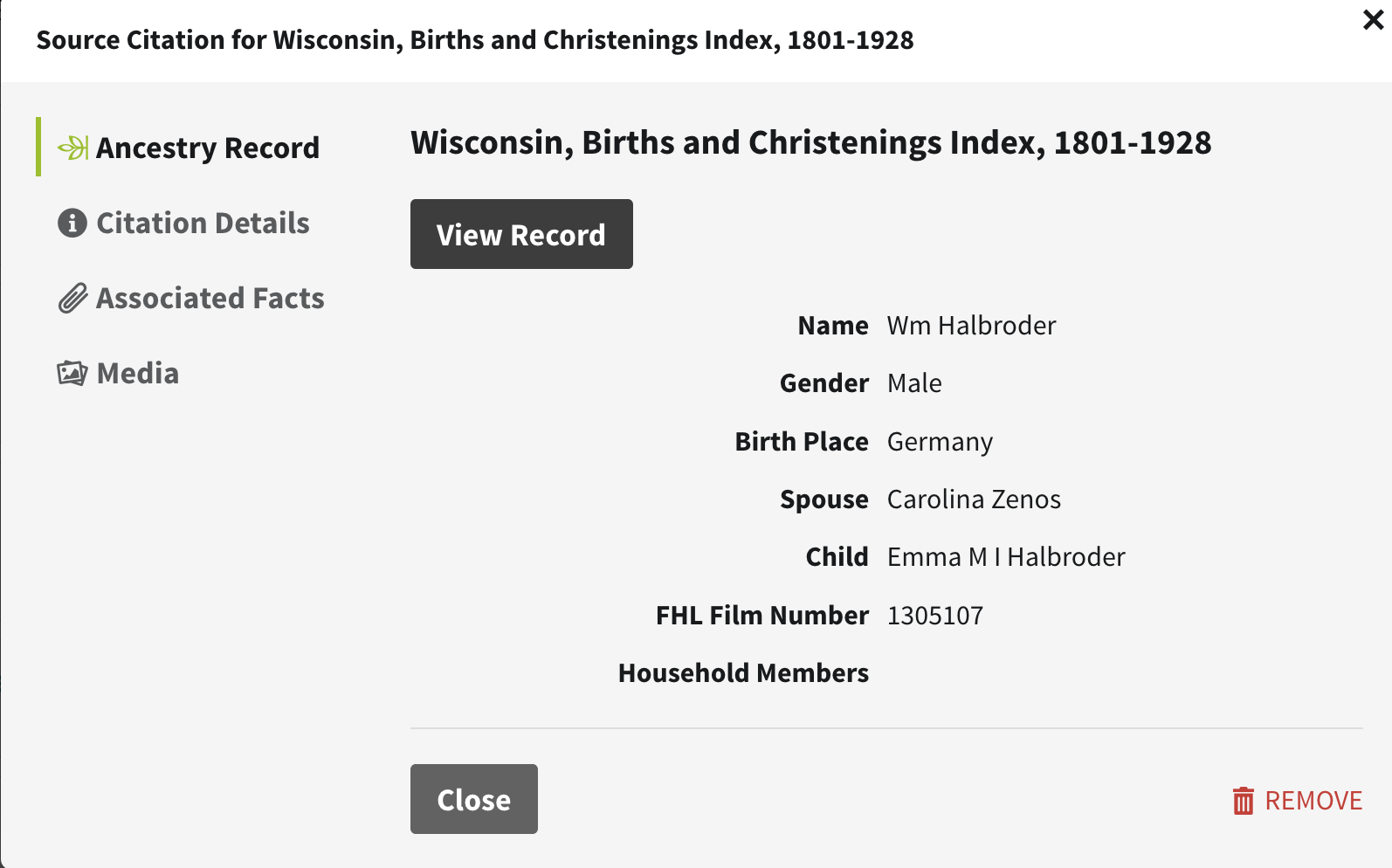
So, I’m presuming that it’s safe to assume that Wilhelm is a likely brother or other relative (cousin?) of Bertha’s. Only once he arrives in the States, he disappears. The only mention of a Wilhelm Halbröder (or William Halbroeder, or any variation on that name) for the rest of the 19th century in any census that I can find, or any city directory, land record, marriage records, birth records for children, etc is in ONE record that I don’t have access to in a pandemic—I’ll have to go to a Family History Center to look at the film and see the record.
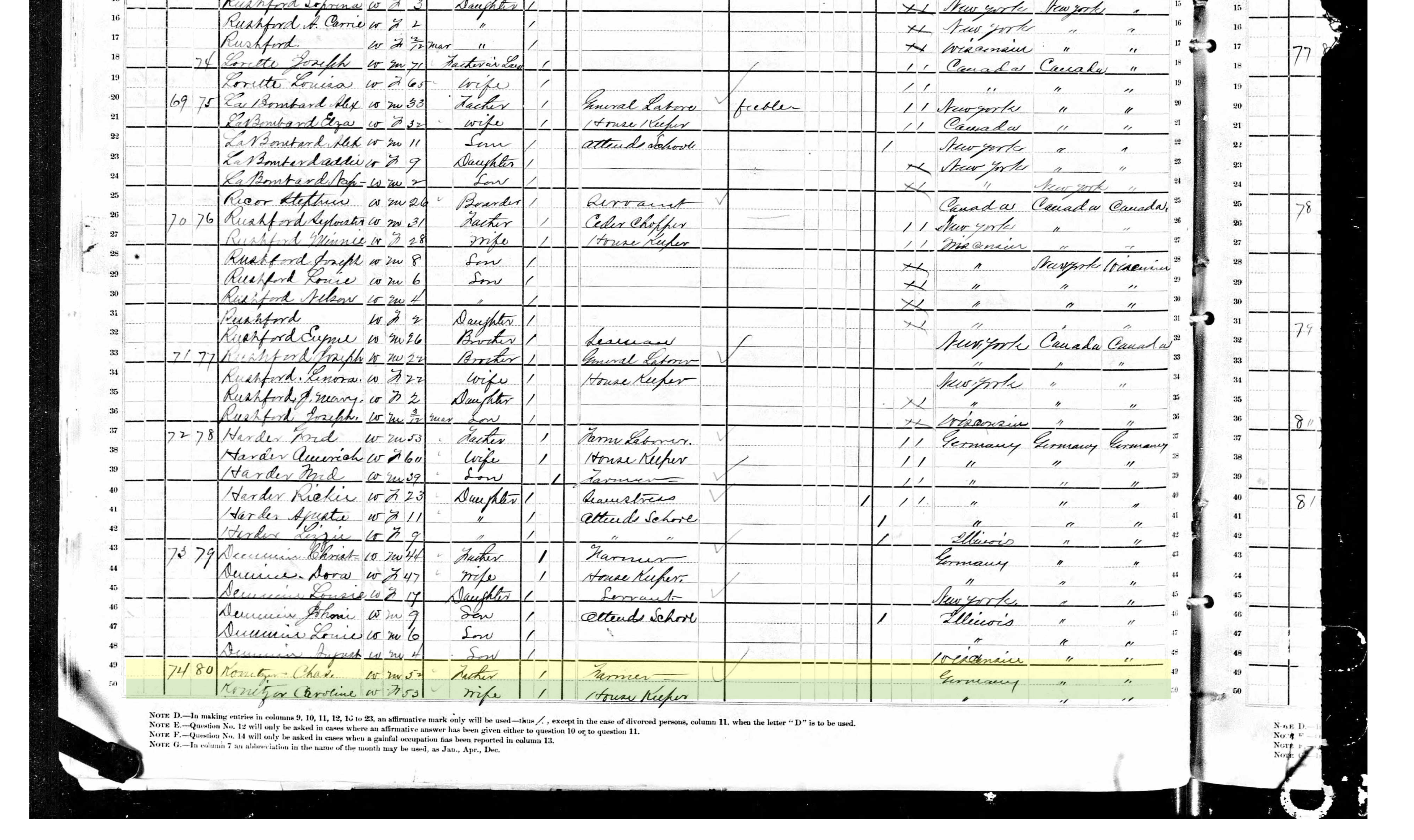
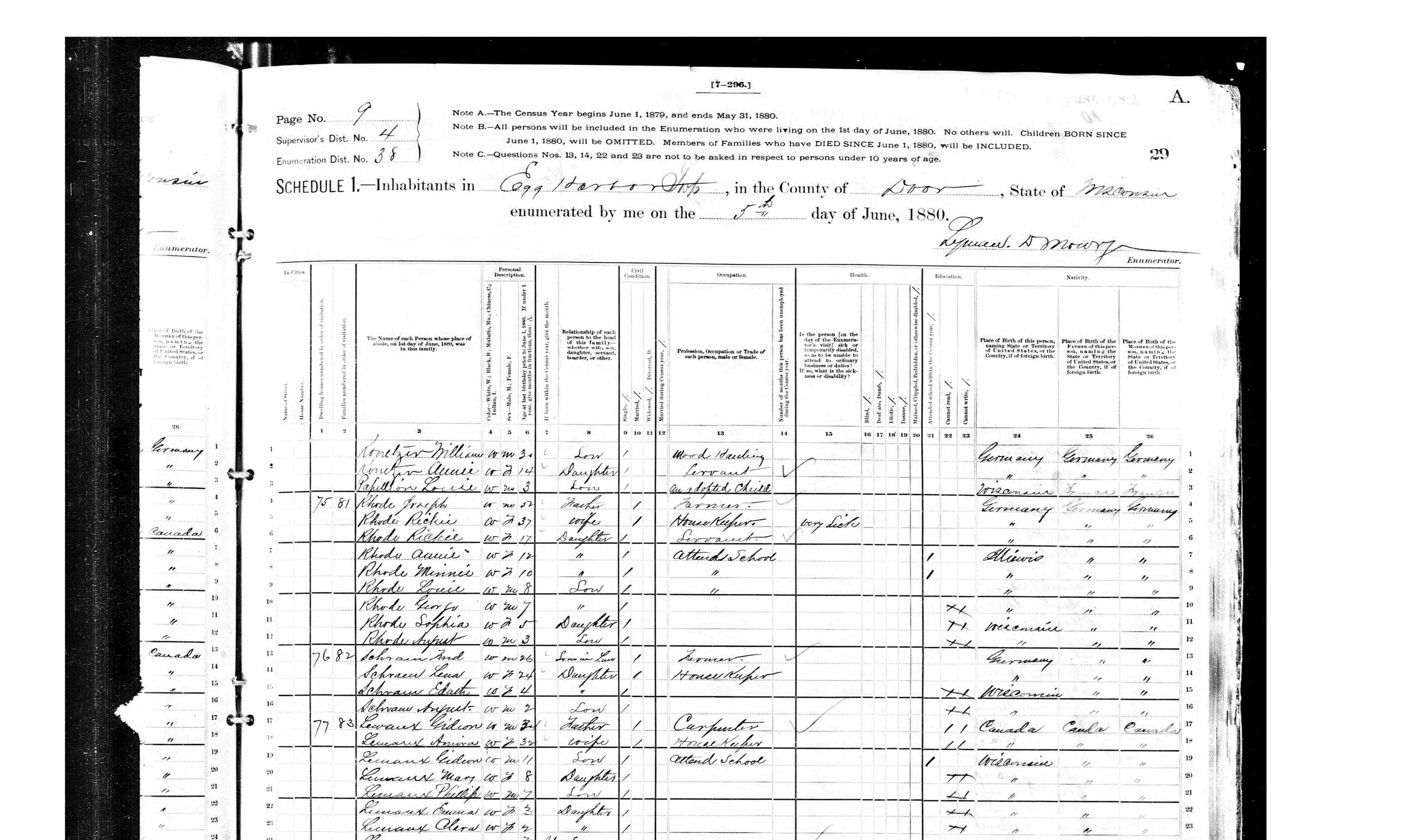
However, Carl and Caroline Konitzer show up on the 1880 census in Wisconsin. Remember how they had no children named Konitzer when they arrived on the ship with Wilhelm and Bertha? Now they have 3, one of whom is named William Konitzer, 30, who is old enough to have arrived with them on the ship, yet is absent from that record. Also note they have a 14-year-old daughter named Annie who of course would have been born after they arrived in 1869, but who is listed as having been born in Germany.
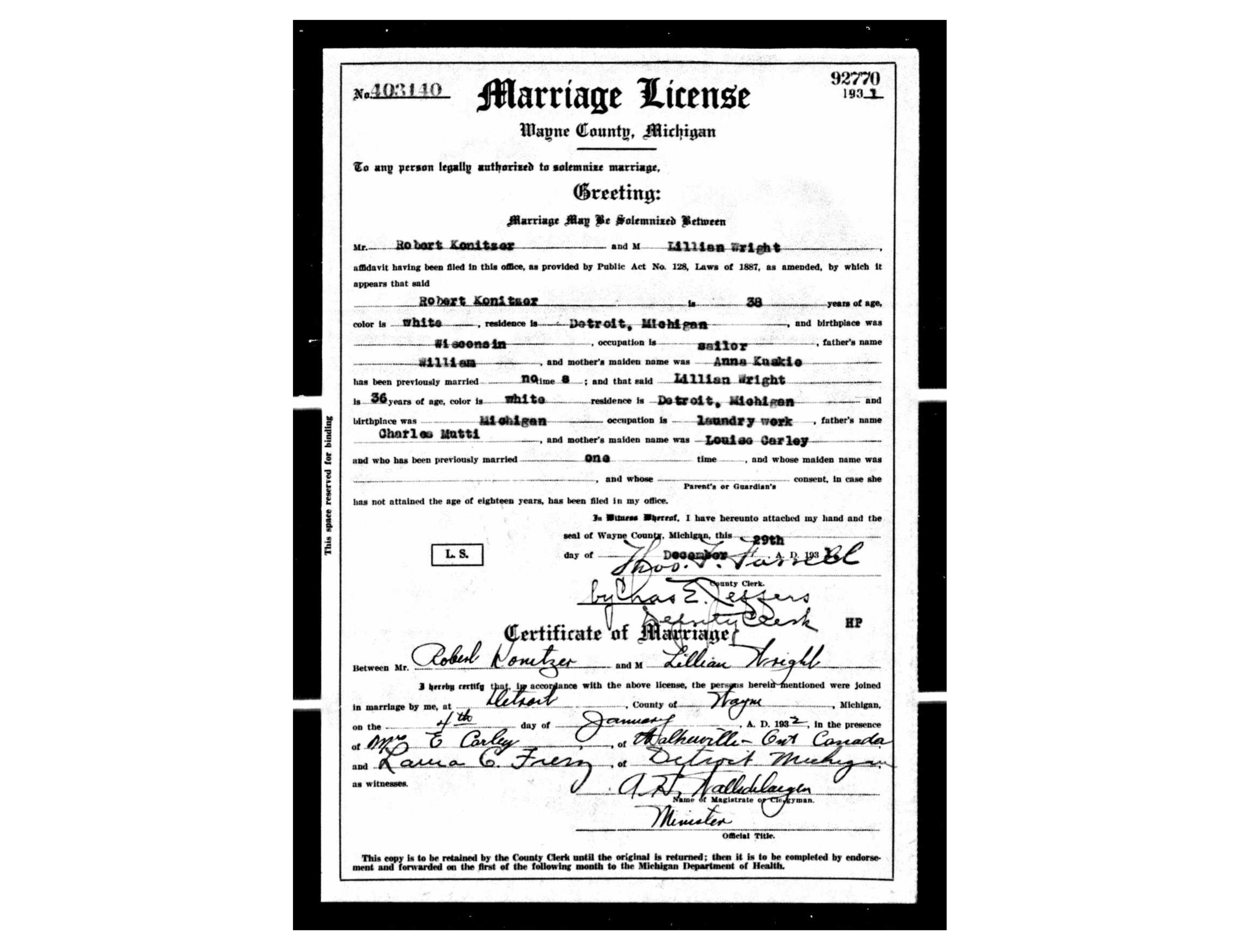
What fascinates me about this is that a few years later, William shows up in Wisconsin records married to a woman named Anna, whose maiden name is NOT Konitzer but Koschkie or Kuskie, according to her son’s marriage certificate, and whose age matches perfectly with that of Annie. Did Annie emigrate alone or perhaps with a family who passed on or got separated at some point, and she came to live with and/or be adopted by the Konitzers (who obviously are a couple who adopt kids), and she and William eventually ended up married? Or is it just a coincidence and William happens to have a sister named Annie who never shows up again (which isn’t unusual for women unless you’re working your way backward—if they get married, you don’t always know who they married because the parents aren’t always listed on the records, if you can find them at all) and also marries an Anna?
And is William Konitzer actually Wilhelm Halbroeder? Who is the Wm. Halbroder who married Carolina Zenos and had a child named Emma? Are they the same person?
Or is Annie in the Konitzer household in 1880 the same person as Anna Halbröder, who we haven’t even discussed yet, who was 9 in 1871 when she arrived with Fern and the other Halbröders, so in 1880 would be closer to 17 or 18 so wouldn’t have been 14, but censuses can be wrong about ages and so can ship manifests, and WHERE ARE ALL THESE ANNIE/ANNAS COMING FROM? (Yes, I know it’s a common name, but why does it have to be THIS common?)
And that brings me back to the beginning of the rabbit hole: Is Caroline Konitzer the mother of Wilhelm, Bertha, and Ferdinand Halbröder? And also Anna, given that Anna is 2 years older than Fern?
Did the parents divorce and Anna and Fern, being too young to emigrate in 1869, or because of some sort of custody arrangement, they emigrated with his father and stepmother and younger sibling baby Johannes?
Or is it just a coincidence that these names are so similar in both families and they’re not related at all? Where did Caroline disappear to? Did she die in Prussia and never emigrate, and the Caroline Konitzer who did emigrate near Bertha was just an aunt or a distant relative by marriage, and maybe Carl was an uncle or something related to her mother who died?
These are the questions that remain, and so far the records in Germany aren’t letting me figure out the answers–either because Ancestry doesn’t have access to the records (there was that big world war and all, plus the other one), or because I don’t have enough information to narrow down the potential choices. All I know is that Friedke is married to an August Halbröder in records from the same area of Prussia, and that I can’t find any records of any Caroline ever being married to an August Halbröder in that area of Prussia.
And maybe it’s all moot and Bertha and Fern were never siblings to begin with, because I have yet to find mention of the two of them in the same written record!
 I’ve long been a fan of mysteries. Trixie Belden was my BFF as a third and fourth grader. Nancy Drew was another favorite. Veronica Mars updated the teen sleuth idea, bringing the storytelling form to a new generation.
I’ve long been a fan of mysteries. Trixie Belden was my BFF as a third and fourth grader. Nancy Drew was another favorite. Veronica Mars updated the teen sleuth idea, bringing the storytelling form to a new generation.
